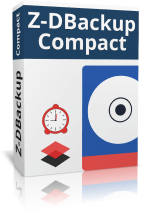Z-DBackup can create complete and consistent backups of Microsoft Exchange Servers including all databases while the server is running (online backup). To do so our software uses Microsoft VSS technology (Volume Shadow Copy Service).
Automated Actions
Alternatively you use Z-DBackup’s automated actions feature to create offline backups of your server. Z-DBackup let’s you configure actions to be executed before a backup (e.g. shutting down a server or database) and after a backup (e.g. starting a server or database).
Complete and Consistent Database Backups
Both online and offline backups ensure that all databases are backed up in a consistent state. A restore will always restore the whole database to the state saved in the backup. Single tables or fields (e.g. a single email) can’t be extracted by Z-DBackup during a restore.
You can use additional software to restore single fields like emails from complete Microsoft Exchange Server backup e.g. Kernel Exchange EDB Viewer.
Backup Strategy and Backup Media
Z-DBackup allows the creation of individual, professional backups of MS Exchange Servers. The software offers different backup strategies, including a generation principle backup rotation scheme for versioned backups (also known as father-son backup, which has the advantage that different versions are readily available and a restore is very easy, however all data is copied during each backup). There are also strategies designed to back up only new or changed data, such as Synchronisation, incremental and differential backups.
After a backup strategy has been chosen, a suitable backup medium must be found. The ideal backup medium is usually a tape library, but also a single tape drive can already be sufficient, depending on your backup plans, because you can simply take each day’s tape home with you to protect the backup from water damage, fire and theft.
The durability of tape mediums is enormous compare to many other mediums. Be sure to keep backups of all software that is relevant to the backups. It might later be needed to restore older file formats and/or retrieve data from old files. Technology and software is steadily advancing and future releases of legacy software may be incompatible with old data.
Online backups as an alternative to tape backups
Another very secure solution is to use online backups. Your backups are stored on a server, and the server contents are again backed up by the hosting company. One must consider whether the additional storage costs are in a good relation to the importance of the data. Data volume is a major cost factor as Exchange server databases can be quiet large. But you have the benefit of being able to access your backups from any location in the world.
Planning a Server Backup
It is generally very advisable to do some test-runs of the backup and restore processes to check if everything is working fine and to gain experience on exactly what to do in an actual emergency. Having the relevant software documentations at hand can be of great help.
The following considerations are important for useful backups:
- Which components must be included in the backup?
- Which backup strategy makes most sense considering needed peripherals and incurring costs?
- How often should the backup be run?
- Is a useful documentation (emergency plan) available to create the Backup Set, run backups, and restore everything including the MS Exchange server in a case of emergency?
Which Data Must Be Included in a Backup?
Exactly what must be backed up? For well-trained system administrators who know their servers like the back of their hand it should be no problem to set up a good backup scheme.
First and foremost, all server functions such as mailboxes, address books, appointment calendars and task lists must be backed up, but that’s not enough, there are also important system settings, services and configurations to consider.
Sever Backup Software
Microsoft Exchange Server Backup with Z-DBackup
Z-DBackup offers a large variety of backup methods and schemes with numerous options for your daily backup. The software is controlled with Backup Sets. Up to 250 Backup Sets can be defined and managed. Backups can be created as 1:1 file copies or as ZIP-compressed backup archives. The file copy method even stores extended NTFS file attributes. File name lengths of more than 260 characters are handled without problems. In many cases, certain programs, scripts or services must be started or stopped before or after the backup. Z-DBackup also easily does this.
Z-DBackup is fully network-enabled and can back up data from and to network drives. The professional version also supports UNC paths (\\Server\Directory), optionally with username and password, to perform a direct network login and automatically logs out again after the backup.

Scheduled Server Backup
Z-DBackup has an integrated, easy-to-use interface to the Windows Task-Scheduler which allows a fully automated backup even when no user is currently logged on to the system.
If you want even more versatility take a look at our task scheduler Z-Cron. It is designed to work hand in hand with Z-DBackup, but furthermore acts as a central control point for the scheduling and automation of software as well as system functions, scripts and services and comes with a large selection of built-in commands which help to ease the automatical system administration.
Server Live Backup
A big challenge for every backup software is backing up files which are already opened by other applications for exclusive access. Open and locked files cannot be read by normal backup programs. This is especially true for databases, which are in many cases always open. The add-on modules Z-VSScopy enhances the features of Z-DBackup and adds support for “live backup”, which includes backups of SQL and EXCHANGE databases.
Z-VSScopy runs completely in the background without you noticing, and gives other software the possibility to access open and locked files. Thus, Z-DBackup gains the possibility to backup such files, while nothing changes for the user. You can even back up complete applications like MS Exchange, SQL, Outlook and Lotus Notes in a live system.